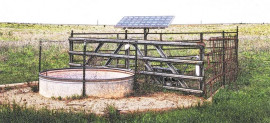
PESHAWAR: A group of electrical engineering students from CECOS University of Information Technology and Emerging Sciences have designed a solar-powered environmentally-friendly car, with a speed of up to 80 kilometres per hour.
A recent report from World Health Organization (WHO) ranked Peshawar as the second most air polluted city in the world.
 PHOTO: EXPRESS
PHOTO: EXPRESSThe report also suggests industrial smokestack emissions should be reduced and the use of renewable power should be increased. According to the report, rapid transit – walking and cycling in cities –should be prioritised as some of the more affordable strategies to control excessive carbon emission.
Pedal, solar power aims to be the new hybrid
This is what gave birth to the idea of a solar-powered car in the minds of Ibrarullah, Ahmad Yosha Muhammad Ghufran, Izaz Ahmad, and Ihsanullah. The team created the car as part of their final year project.
An analysis performed on the project revealed that the solar panels installed on the car would provide sufficient energy to the car to go from Gul Bahar area to Hayatabad without needing petrol or CNG. The car can run for 25 kilometres on a fully charged battery.
Ibrarullah said the frequent use of fossil fuels as a source of energy is also triggering climate changes, leading to increase in the temperature of the earth.
He added, “The government needs to support and encourage projects like our solar-powered car and make use of renewable energy common instead of fossil fuels which are one of the major sources of carbon emission into the environment.”
 PHOTO: EXPRESS
PHOTO: EXPRESSHow the car works?
A solar panel has been fitted on top of the car to collect energy from sunlight which will charge the four dry batteries fitted in the rear portion of the car. The battery’s lifespan is up to four years.
The battery, when charged, will run a direct current (DC) motor installed in the car in place of engine through mechanical gearing system to rotate the wheels. The car does not have an engine and runs solely on the combination of solar panels, batteries, and DC motor. An electronic circuit has been installed in the car to control speed of the vehicle.
Solar Impulse 2 begins Atlantic crossing
The students have also installed a plug-in charging port into the car. “Everyone can simply charge the car at their homes or any other place where electricity is available,” Ibrarullah said.
 PHOTO: EXPRESS
PHOTO: EXPRESSThe team explained that solar energy has been used in this project because it is available easily and doesn’t generate any sort of pollution including air or noise.
Android apps supported
The car is supported by an android application. Khalid Rehman, an assistant professor at CECOS University and the team’s supervisor, told The Express Tribune the car starts through an android app and the windows and the solar panel adjustment is also done through it. The app makes the operation secure and more comfortable for the user.
“It is android apps supported as in today’s modern technological era users want ease and prefer automatic than manual systems,” Rehman says.
He suggested if the students were to be supported by the government they could easily introduce the solar-powered car for commercial use in the near future.
Published in The Express Tribune, July 19th, 2016.





















1713281138-0/US-Treasury-Secretary-Janet-Yellen-(2)1713281138-0-270x192.webp)















COMMENTS (5)
Comments are moderated and generally will be posted if they are on-topic and not abusive.
For more information, please see our Comments FAQ